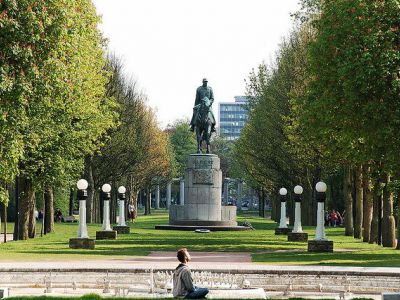
King Albert Park, Ghent
King Albert Park, also known as South Park (Zuidpark), is a city park in the southeastern part of Ghent, nestled between Woodrow Wilson Square and the exits of the B401 highway. This neo-Baroque park stands out among Ghent's green spaces, which are predominantly designed in the English landscape style. The park's origins date back to the 1930s when it was established on the former railway site of the demolished Gare du Midi, which had been replaced by the Gent-Sint-Pieters station. Following the death of King Albert I in 1934, the park was officially named King Albert Park.
Initially laid out in an Art Deco style, the park featured sleek geometric designs, an Art Deco post office at its northern end, and a bandstand. In 1956, the Propaganda Centre was added, along with an administrative building for the Municipal Electricity, Gas, and Water Services. Although architect Gaston Eysselinck had plans to construct exhibition palaces, these were never realized. Over time, the park also became home to a monument dedicated to King Albert, a monument for the fall of the world wars, a statue of a wounded swordsman, and a bust of Karel Van de Woestijne, which was later removed due to vandalism.
King Albert Park has seen major changes over the years. Before World War II, it was surrounded by low-rise buildings and mansions, which were replaced by offices and apartments after the war. In 1969-1970, part of the park was lost to a motorway connecting to the E17, increasing traffic. The city's Administrative Center was built to the north in the early 1990s, visually separating the park from Woodrow Wilson Square. Later in the 1990s, the park's plantations and flowerbeds were replaced with low-maintenance gardens, and its remaining Art Deco features were removed during a 2006 redevelopment.
Initially laid out in an Art Deco style, the park featured sleek geometric designs, an Art Deco post office at its northern end, and a bandstand. In 1956, the Propaganda Centre was added, along with an administrative building for the Municipal Electricity, Gas, and Water Services. Although architect Gaston Eysselinck had plans to construct exhibition palaces, these were never realized. Over time, the park also became home to a monument dedicated to King Albert, a monument for the fall of the world wars, a statue of a wounded swordsman, and a bust of Karel Van de Woestijne, which was later removed due to vandalism.
King Albert Park has seen major changes over the years. Before World War II, it was surrounded by low-rise buildings and mansions, which were replaced by offices and apartments after the war. In 1969-1970, part of the park was lost to a motorway connecting to the E17, increasing traffic. The city's Administrative Center was built to the north in the early 1990s, visually separating the park from Woodrow Wilson Square. Later in the 1990s, the park's plantations and flowerbeds were replaced with low-maintenance gardens, and its remaining Art Deco features were removed during a 2006 redevelopment.
Want to visit this sight? Check out these Self-Guided Walking Tours in Ghent. Alternatively, you can download the mobile app "GPSmyCity: Walks in 1K+ Cities" from Apple App Store or Google Play Store. The app turns your mobile device to a personal tour guide and it works offline, so no data plan is needed when traveling abroad.
King Albert Park on Map






Sight Name: King Albert Park
Sight Location: Ghent, Belgium (See walking tours in Ghent)
Sight Type: Attraction/Landmark
Sight Location: Ghent, Belgium (See walking tours in Ghent)
Sight Type: Attraction/Landmark
Walking Tours in Ghent, Belgium
Create Your Own Walk in Ghent
Creating your own self-guided walk in Ghent is easy and fun. Choose the city attractions that you want to see and a walk route map will be created just for you. You can even set your hotel as the start point of the walk.
Ghent Introduction Walking Tour
Some historians believe "Ghent" comes from the Celtic word, "ganda." "Ganda" meant a confluence, as with two rivers. There are traces of human settlements as far back as the stone age at the confluence of the rivers Scheldt and Leie in Belgium.
With the Frankish invasions at the end of the 4th century AD, the Celtic language was replaced by Old Dutch and this... view more
Tour Duration: 2 Hour(s)
Travel Distance: 1.7 Km or 1.1 Miles
With the Frankish invasions at the end of the 4th century AD, the Celtic language was replaced by Old Dutch and this... view more
Tour Duration: 2 Hour(s)
Travel Distance: 1.7 Km or 1.1 Miles
Ghent's Historical Buildings
The medieval city of Ghent is full of wonderful old buildings, some dating back as far as the 12th-13th centuries. Medieval buildings are indeed everywhere here, and if you're interested in the heritage fit to capture you imagination, you will find plenty of it in Ghent’s historic downtown.
And you won’t have to look far for the World Heritage worthy of its name either. The Castle of... view more
Tour Duration: 2 Hour(s)
Travel Distance: 2.8 Km or 1.7 Miles
And you won’t have to look far for the World Heritage worthy of its name either. The Castle of... view more
Tour Duration: 2 Hour(s)
Travel Distance: 2.8 Km or 1.7 Miles


